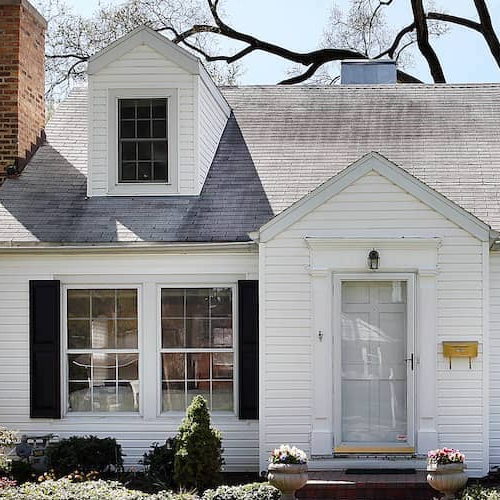How much does a tiny home cost?
Contributed by Sarah Henseler
Dec 23, 2025
•6-minute read

If you're someone who is interested in a minimalistic or sustainable lifestyle, a tiny home can make for an attractive alternative. You might be seeking lower-cost housing without skimping on the comfort or privacy. Or, maybe you desire an option that makes it easy for you to travel or relocate.
Whatever the reason may be, a tiny house – which usually ranges between 100 and 400 square feet – might be on your radar. The microhouse cost hinges on many factors, such as the size, materials, location, and whether it's a custom build or prebuilt. According to HomeAdvisor, it can cost anywhere from $30,000 to $60,000 to build a tiny home in 2025, and the average is $45,000.
Learning about the costs can help you prepare your budget and make sure you can afford a tiny house in your future.
What is the average cost of a tiny house?
The average nationwide cost of a tiny home is $300 – $400 per square foot, compared to a traditional home’s $150 per square foot, making tiny homes typically cheaper to build or purchase. While the average cost of this type of house is around $30,000 – $60,000, they can cost as little as $4,000 or as much as $180,000, depending on the amenities you choose. This is lower than the national average for a traditional home, which currently stands at $225 per square foot.
Many factors can impact the price tag:
- Buying versus building
- Tiny home size and complexity
- Use of wheels versus a foundation
- Building materials and labor
- Local building permit costs
- Utility access
- Home features/amenities
- Appliances and furnishings
While customizing your home to your preferences, lifestyle, and budget can make it easier to control costs, getting a prebuilt tiny home is usually less expensive than a customized one. Usually, a prebuilt tiny home is the cheaper option.
Costs of building a tiny house
Although building a tiny house is generally the most affordable option, building the house yourself can require a significant investment up front. As such, it’s important to mentally, physically, and financially prepare for the process.
Most tiny home builders spend $30,000 – $60,000, depending on your preferences, cost of labor, and supply of building materials.
|
Cost factor |
Average cost |
|
Size |
$150 per sq. ft. |
|
$3,000 – $150,000 |
|
|
Foundation (for tiny houses on land) |
$4 – $7 per sq. ft. |
|
Wheels and trailer (for tiny houses on wheels) |
$4,500 – $9,000 |
|
Professional labor |
30% – 60% of project total |
|
Construction materials |
$14,100 – $54,800 |
|
Maintenance and repairs |
$550 – $1,000 per year |
|
Utility access |
$750 – $25,000 |
|
Building permits |
$500 – $3,100 |
|
Prefab kit |
$4,000 – $10,000 |
|
Custom built |
Over $150,000 |
|
Appliances |
$400 – $4,000 |
|
Insurance |
$100 per month |
Source: HomeAdvisor
Costs of buying a tiny house
If building a custom home from scratch isn’t exactly for you, you can purchase a prebuilt tiny home. Start by finding prefabricated tiny home providers across the country. They might even offer free shipping.
While you can save a significant time and effort this way, it’s not uncommon for prebuilt tiny homes to start at $9,500 and end up costing $150,000 or more – especially after adding luxury features and finishes.
Buying a preowned tiny house could be the cheaper route. However, when you buy preowned, you're trading off the level of control you would have had over how your space is set up. Since tiny homes are often highly customizable, you can tailor the space to your needs, but you’ll likely spend more money.
You can find tiny homes for sale in your area by searching local listings and national websites. Unlike traditional homes, most tiny homes don’t qualify for a traditional mortgage, so you’ll need to pay with cash or seek other financing options.
Unforeseen costs of tiny homes
While you might be fully aware of the more obvious expenses – like the costs of purchasing land and building materials – there are some costs and building-related factors that might not cross your mind.
- Zoning laws: Depending on where you live, zoning laws may impact how your house gets built and where you can build it. Case in point: your area may not allow putting your tiny house on a friend or family member’s land for free.
- Utilities: Your tiny home will require access to water and electricity. Depending on the location, you can hook up to local utilities. However, if your house is off-grid, you may need to install a septic system or renewable energy sources, like solar panels.
- Furniture and appliances: You may need to buy smaller furnishings and compact appliances if your existing full-sized items don’t fit in your tiny home.
- Storage: You may need to rent a storage unit if your belongings don’t fit your tiny home’s limited space. You can also donate or sell these items.
- Home insurance: Zoning laws and restrictions can make getting homeowners insurance for a tiny home complicated. It might be difficult to determine what kind of insurance a tiny house might need. For example, whether a tiny house falls under a standalone residence or an ADU depends on local zoning laws. However, coverage for a tiny house might be available through mobile home or RV insurance.
- Resale value: Tiny houses aren’t guaranteed to increase in value over time. In fact, they may depreciate, especially if they’re highly customized. Additionally, because tiny homes are a niche market, it can be harder to resell them.
- Moving costs: If your tiny home isn't being built on site, there are costs tacked on to transporting it to its destination. Per HomeGuide, the average moving costs for a tiny house is $200 – $1,500 if you're moving it up to 250 miles, or $1,000 – $5,000 for moves over 250 miles.
How to get and finance your tiny home
Here are the steps to take to financing a tiny home:
1. Find the right land
If you’re building a tiny home on a permanent foundation, the first step is to find and purchase land. Leasing land for a manufactured home is an easier option, but the value of the home will depreciate over time. Whenever you find a community you’re interested in, check what effect their zoning laws and regulations could have on building your home.
2. Consider taking out a land loan
Not being able to purchase a tiny house with a traditional mortgage doesn’t mean there aren’t other financing options, such as land loans. While Rocket Mortgage® doesn’t offer land loans, we do prioritize educating our clients on their full suite of options.
Land loans are secured the same way home buyers get a mortgage loan. However, it can be more challenging to determine the value of land with no property collateral than to determine the value of a house for sale with an assigned dollar amount. This makes land loans a higher risk for lenders, which typically results in larger down payments and higher interest rates compared to traditional home loans.
To qualify for a land loan, you’ll need to make a significant down payment and have a good credit score. Another key step is to create a solid, detailed plan describing how you want to develop the land. The plan will demonstrate to lenders your commitment to achieving your goal and paying off your loan.
3. Compare tiny house prices:
Like most traditional houses, stick-built tiny homes are built on a foundation and are usually the most expensive. If you want to build a tiny home but don’t want to start from scratch, you can purchase a tiny house shell, which has a finished exterior and unfinished interior. Buying a shell can cut down on time and effort – but you'll want to be careful. The more you customize the home with high-end features, the less affordable this option will become.
You can also purchase kit homes for less than $10,000. These kits include blueprints, a customized trailer to build on, and a list of necessary supplies. But even with a kit, it’s best to only tackle building a tiny home if you have extensive construction experience.
Based on your budget, manufactured homes and modular homes are other types of tiny homes you may want to consider during your hunt.
4. Fund your tiny house construction
If you’re building your tiny home, a construction loan can help you get started. A construction loan is a short-term loan that covers the costs of custom home building. Once the home is built, you’ll apply for a mortgage to pay for the completed home.
There are different types of construction loans. Deciding which loan is right for you will depend on the amount of financing you need and the specifics of the project you plan on executing.
Rocket Mortgage doesn’t offer most construction loans. However, current homeowners can opt for a cash-out refinance to access their home equity and fund the construction. Financing with a personal loan is another funding option tiny home buyers can explore.
The bottom line: Create a realistic budget for your tiny house
While usually less expensive than traditional homes, the price tag of a tiny home can vary based on a host of factors: whether it's prebuilt or custom, on the materials, land, wheels and trailer, foundation, size, insurance, maintenance and repair, to name a few. To narrow down the costs, you'll want to figure out what route you want to take and do your homework ahead of time.
While Rocket Mortgage doesn't currently offer tiny home financing, you can speak with one of our Home Loan Experts to see if you're interested in financing a traditional home purchase.

Jackie Lam
Jackie Lam is a seasoned freelance writer who writes about personal finance, money and relationships, renewable energy and small business. She is also an AFC® financial coach and educator who helps creative freelancers and artists overcome mental blocks and develop a healthy relationship with their finances. You can find Jackie in water aerobics class, biking, drumming and organizing her massive sticker collection.
Related resources
6-minute read
Modular vs. manufactured homes: What's the difference?
Modular and manufactured homes are both factory-built, but they have some key differences. Uncover the distinctions between modular and manufactured homes.
Read more

8-minute read
Is buying a house a good investment?
Is buying a house a good investment? It can be, depending on your personal circumstances. Before you buy, discover the pros and cons of purchasing a home.
Read more
6-minute read
Builder's risk insurance: What is it, what does it cover and should you get it?
Builder’s risk insurance protects properties under construction from damages. See whether you might be a good candidate for a builder’s risk insu...
Read more